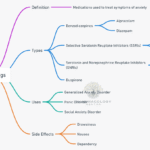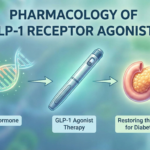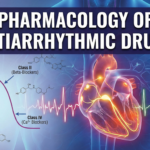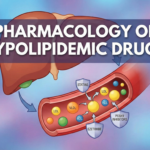Brief Summary
Drugs can increase monoaminergic transmission by inhibiting the metabolism or reuptake of neurotransmitters such as serotonin (5-HT) and noradrenaline (NA).
MAO Inhibitors
- MAO-A and MAO-B are enzymes involved in the metabolism of monoamines.
- Non-selective MAO inhibitors (Tranylcypromine, Isocarboxazid, Phenelzine) irreversibly inhibit both MAO-A and MAO-B.
- These drugs exhibit many drug and food interactions, including the “cheese reaction” which can lead to a hypertensive crisis.
- Reversible inhibitors of MAO-A (RIMA), such as Moclobemide, selectively and reversibly inhibit MAO-A, without exhibiting a cheese reaction.
- Selective MAO-B inhibitors, such as Selegiline, only inhibit MAO-B and are useful in Parkinsonism.
Reuptake Inhibitors
- Drugs may inhibit the reuptake of both serotonin and nor-adrenaline (non-selective reuptake inhibitors, e.g. tricyclic antidepressants) or only serotonin (selective serotonin reuptake inhibitors: SNRIs).
I. Tricyclic antidepressants
Tricyclic Antidepressants and Serotonin-Noradrenaline Reuptake Inhibitors Tricyclic Antidepressants (TCA) inhibit serotonin and noradrenaline reuptake, leading to increased transmitter concentration in the synaptic cleft. Bupropion also inhibits dopamine reuptake. TCA’s long latency for antidepressant action is due to the desensitization of presynaptic receptors. Adverse effects of TCAs include sedation, weight gain, anticholinergic and weak α-blocking property, postural hypotension, and cardiac arrhythmias at toxic levels. Amoxapine blocks D2 receptors and has antipsychotic properties, but it also causes extrapyramidal symptoms and convulsions. TCA overdose presents with cardiac arrhythmias, hypotension, and anticholinergic signs. Treatment includes intravenous sodium bicarbonate, lignocaine, intravenous fluids, and diazepam. Physostigmine should only be used in patients with coma or those with convulsions or arrhythmias resistant to standard therapy.
Tricyclic Antidepressant Poisoning Clinical Presentation: TCA overdose presents with cardiac arrhythmias, hypotension, anticholinergic signs, confusion, delirium, and hallucinations. Cardiotoxic effects are responsible for mortality.
Treatment Intravenous sodium bicarbonate is the most effective intervention for TCA cardiovascular toxicity. Lignocaine is the drug of choice for TCA-induced ventricular dysrhythmias. Intravenous fluids are preferred in hypotensive patients, while dopamine can be used if needed. Diazepam is the drug of choice in the management of acute-onset seizures, while phenytoin or phenobarbital may be used as second-line drugs. Physostigmine should only be used in specific cases.
II. Serotonin Noradrenaline Reuptake Inhibitors (SNRI)
- Non-selective reuptake inhibitors of both 5-HT and NA, but safer than TCAs and considered the drug of choice for severe depression.
- Includes venlafaxine, desvenlafaxine, duloxetine, milnacipran, and levo-milnacipran.
- Duloxetine is the longest acting SNRI and is indicated in neuropathic pain and fibromyalgia.
Click here to go to the detailed chapter on: Selective Serotonin Reuptake Inhibitors (SSRI)
Description: These drugs inhibit the reuptake of 5-HT only (not NA) and lack anticholinergic and α blocking properties.
Indications: SSRIs are now the first choice drugs for depression, phobias, OCD, PTSD, bulimia, premenstrual tension syndrome and panic attacks.
Advantages over TCAs:
- No anticholinergic adverse effects
- No sedation or weight gain
- No propensity to cause seizures or arrhythmias
Adverse effects:
- Nausea, anxiety, diarrhea, headache, insomnia, and inhibition of ejaculation/anorgasmia are common.
- Coadministration of SSRIs with MAO inhibitors can result in serotonin syndrome.
- SSRIs can cause akathisia and abnormal bleeding due to affecting platelet serotonin levels.
Important compounds:
- Fluoxetine: prototype SSRI and longest-acting drug in this group.
- Fluvoxamine: shortest-acting SSRI.
- Paroxetine, sertraline, and citalopram: other SSRIs.
- Escitalopram: most specific SSRI.
- Paroxetine: most teratogenic among SSRIs.
ATYPICAL ANTIDEPRESSANTS:
Introduction
- Atypical antidepressants have different mechanisms and may or may not increase monoaminergic levels.
Trazodone
- Prominent α blocker and weak 5-HT2 antagonist.
- Adverse effects: sedation, priapism, and postural hypotension.
Mianserin
- Acts by blocking presynaptic a2 receptors.
- Adverse effects: seizure augmenting and bone marrow depressant actions.
Tianeptine and Amineptine
- Acts by enhancing serotonin reuptake.
- Mechanism is opposite to SSRIs.
Mirtazapine
- Inhibits presynaptic a2 receptors and increases NA and 5-HT release.
- Selective activation of 5-HT1 receptors due to antagonistic activity at 5-HT2 and 5-HT3 receptors.
- Minimal sexual side effects compared to SSRIs.
- Adverse effects: sedation, weight gain, lipid abnormalities, and dizziness.
Vortioxetine
- Serotonin reuptake inhibitor with 5HT3 antagonistic and 5HT1A receptor agonistic action.
- Indicated for major depressive disorder.
Bupropion
- Inhibits the uptake of NA and DA.
- Presynaptic release of catecholamines.
- Adverse effects: can precipitate seizures at high doses.
Nefazodone
- Blocks serotonin reuptake and antagonizes 5-HT2 receptors.
- Lacks anticholinergic effects and agitation.
- Short half-life and hepatotoxic.
Atomoxetine
- Selective inhibitor of NA reuptake.
- Useful for Attention Deficit Hyperkinetic Disorder.
Vilazodone
- Serotonin reuptake inhibitor and partial agonist at 5HT1A receptors.
Disclaimer: This article is for informational purposes only and should not be taken as medical advice. Always consult with a healthcare professional before making any decisions related to medication or treatment.
Also visit this page for detailed overview of Pharmacology of Antidepressants:
📚 AI Pharma Quiz Generator
🎉 Quiz Results
Medical Disclaimer
The medical information on this post is for general educational purposes only and is provided by Pharmacology Mentor. While we strive to keep content current and accurate, Pharmacology Mentor makes no representations or warranties, express or implied, regarding the completeness, accuracy, reliability, suitability, or availability of the post, the website, or any information, products, services, or related graphics for any purpose. This content is not a substitute for professional medical advice, diagnosis, or treatment; always seek the advice of your physician or other qualified health provider with any questions you may have regarding a medical condition and never disregard or delay seeking professional advice because of something you have read here. Reliance on any information provided is solely at your own risk.









